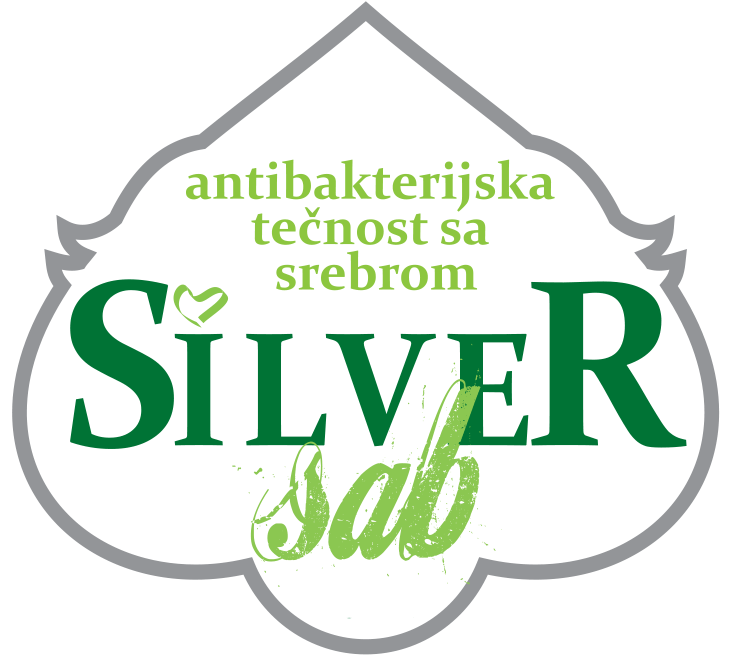- +381 13 366 163
- info@silver-sab.rs
The active ingredient of Silver Sab is SILVER ZEOLITE!
WHY SILVER?
The antibacterial activity of silver and its compounds was well known in early history. Even the ancient Greeks and Romans used silver to prevent infections, and in the Middle Ages, silver was used to treat burns and wounds.
American settlers threw the silver coins in milk to prevent lactic-acid fermentation. The sailors on their long journeys put silver coins in barrels of wine and water to disinfect them in the 19th century.
In Germany, also in the 19th century, they were using the eye drops for babies based on silver compounds to prevent infections. In churches, only one silver spoon is used by hundreds of believers during the communion and that spoon never caused spread of infections. Silver solutions were approved for use in 1920 by the US Food and Drug Administration as antibacterial agents.
Today, silver is used in special types of institution for preventing infections, in urinary catheters (silver thread) to prevent the development of urinary tract infections, and silver sulfadiazine is used in creams for burns. Today, even the components of modern air conditioners, washing machines, refrigerators and other home appliances are starting to be produced based on silver.
The first who started the scientific research on the mechanism of action of SILVER on the microorganism cell was a Swiss botanist Karl Wilhelm von Nageli, in the 80s of the 19th century. He found that the destruction of the microorganism cell does not cause the metal itself, but its ions. This phenomenon he called "oligodynamic". This scientist proved that Silver has oligodynamic effect only in the dissolved, ionized form. Later, his conclusions were confirmed by other researchers.
German scientist Vincent comparing the activity of certain metals, came to the conclusion that Silver has the strongest bactericidal effect, and copper and gold weaker effect. Thus, for example, the Staphylococci on Silver plate was dying for 2 days, on copper – for 3 days, and on gold – for 9 days. The diphtheria bacteria on a silver plate would die within 3 days, on copper for 6 days, and on gold – for 8 days. We should have in mind that these experiments were executed on a metal basis, and not in an ionized solution.
V.S Brizgunov with a group of authors published a study that proves that Silver has an extremely powerful antimicrobial activity. At the clinics, they examined bacteria that were of particular interest to doctors – Staphylococcus aureus, Proteus vulgaris, purulent streptococcus and stomach streptococcus. In clinical studies, the silver ions had different affect on different types of bacteria – from the bactericidal effect (ability to kill microbes) to bacteriostatic effects (ability to prevent multiplication of bacteria) and the results were astounding.
A number of scientists found that silver ions inactivate the influenza viruses from group A- 1 and B, some enteroviruses and adenoviruses and also inhibits the AIDS virus, and it shows a good therapeutic result in the treatment of viral diseases. They noticed the great advantage of Colloidal silver therapy compared to standard therapy. L.V. Grigorjeva has experimentally determined that for the treatment of coxsackie virus serotypes A-5, A-7 and A-14, it needs a significantly higher concentration of silver from 0.5 to 5 mg / l, than for Escherichia, Salmonella and other stomach bacteria (0.1 to 0.2 mg / l).
There are many theories that explain the mechanism of action of silver ions on microorganisms. The most widespread is “theory of adsorption” by which cells lose viability due to the interaction between the electrostatic forces generated between the bacterial cell that has a negative charge and positively charged silver ions, which are gluing to a bacteria cell. Other researchers give particular importance to physical and chemical processes, i.e. oxidation of protoplasm of bacteria in which SILVER plays the role of catalyst. Voraz and Tofern in 1957 explained antimicrobial oligodynamic effect of silver in which silver ions bind to enzymes containing SH and COOH groups, and Tonle and Wilson – disruption of osmotic balance of the cells. If, therefore, we summarize all these theories, it appears that the mechanism of action of silver on bacteria cell is multistage. Silver ions are gathered on the cell membrane, the cell remains alive but it violates some of its functions, such as, for example, the reproduction. Silver ions continue to penetrate the interior of the cell through the membrane and inhibit enzymes chain of breathing and of oxidation processes, which is why the cells die.
Experiments have shown that in co-incubation of the living mouse brain tissue and various microorganisms in a solution containing silver ions, the morphology of erythrocytes and leukocytes remains unchanged, while the microorganisms are destroyed. The cells of mouse tissues get the round shape, but there is no change in their membranes. They maintained the ability to reproduce, preserved normal cell structure and viability. These studies show that silver ions do not seem deadly to the macro-cells, but only on microorganisms.
In the light of modern knowledge, SILVER is considered to be a very powerful remedy which actively works against pathogenic bacteria and viruses.
WHY ZEOLITE?
ZEOLITE is the miraculous mineral with amazing healing effect. Many refer to it as the “stone of the future”. Mineral ZEOLITE (which belongs to the family of natural minerals, as its synthetic form) was first used to clean the water that has been contaminated by radioactive and similar pollution’s. During the Chernobyl catastrophe, it has been successfully used to prevent water contamination by radioactive substances.
Natural zeolite originated in ancient times from volcanic lava, when the volcanic rocks and ash came into contact with alkaline groundwater. The natural ZEOLITE itself has no useful features while it is not technologically processed, i.e. micronized, heat-treated, sterilized and hermetically kept so it could be used for human needs, and for other purposes (animal nutrition, land breeding, drinking water treatment, and wastewater treatment). For human use, the only allowed zeolite is the clinoptilolite which is rich with minerals, the sodium or calcium aluminosilicate.

